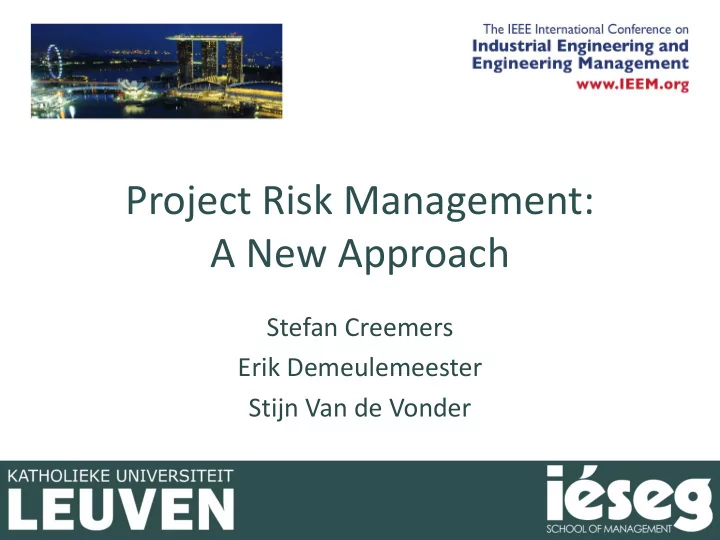

Project Risk Management: A New Approach Stefan Creemers Erik Demeulemeester Stijn Van de Vonder
Risk management 101 Risk identification Risk analysis Risk mitigation Risk control
Risk management 101 Risk identification • Quantify probabilities and impacts of risks • Assess the impact on project objectives Risk analysis • Calculate the project objectives Risk mitigation Risk control
Risk management 101 Risk identification • Quantify probabilities and impacts of risks • Assess the impact on project objectives Risk analysis • Calculate the project objectives Risk mitigation Where to start? Risk control
Project risk management: current approach Uncertainty is captured in activity durations: Normal distribution Triangular distribution Beta distribution Monte Carlo simulation is used to obtain estimates of project objectives (e.g. cdf of the completion time)
Project risk management: current approach Uncertainty is captured in activity durations: Normal distribution Triangular distribution Beta distribution Monte Carlo simulation is used to obtain estimates of project objectives (e.g. cdf of the completion time)
Risk mitigation: how is it done? TORNADO GRAPH
Risk mitigation: how is it done? TORNADO GRAPH Focus mitigation efforts on the most sensitive activity; the activity that has the highest rank
Ranking activities: existing measures Criticality index Significance index Cruciality index Schedule sensitivity index
Problems with the current approach • Project managers have a very hard time to model uncertainty • All of the previous ranking measures have been criticized • It is not clear where the uncertainty originates from • It is unclear how to mitigate uncertainty
New approach: risk-driven (instead of activity-based)! Risk 1 ACT 1 Risk 2 Activity duration distribution (ACT 1) Risk 1 ACT 2 Risk 3 Risk 4 ACT 3 Risk 5 … Project Risk 1 Risk 2 Risks 1&2
Ranking risks: proposed measures Cruciality index Critical Delay Contribution (CDC)
Advantages of the new approach • Risks are much easier to predict than uncertainty • CDC is calculated on risk per activity basis and can be aggregated on the level of risks and activities • Risks root causes are ranked => we know which risk to mitigate!
Risk-driven = ranking of risks rather than activities TORNADO GRAPH
Risk-driven = ranking of risks rather than activities TORNADO GRAPH
Evaluation of the new approach using a computational experiment For a large set of projects (600 projects of PSPLIB 120): – Model uncertainty (i.e. define risks, impacts, probabilities…) – Simulate the project execution – For each ranking measure: Calculate the highest-ranked risk according to the measure Eliminate the highest-ranked risk (i.e. focus our mitigation efforts on this risk How good do the measures perform when mitigating 10 risks?
Computational experiment: ranking measures ACTIVITY-BASED RISK-DRIVEN => => SELECT THE LARGEST RISK THAT IMPACTS THE SELECT THE LARGEST RISK HIGHEST-RANKED ACTIVITY CDC ACT CDC RISK CI ACT CI RISK SSI SI ACI
Results
Results Project Delay Number of risks eliminated
Results Project Delay Random Number of Solution space risks eliminated Greedy Optimal
Results ACI SI
Results CI act SSI
Results CDC act CDC = best of activity- based measures
Results CI risk CDC act
Results CI risk CDC risk CDC = best of risk-driven measures
Conclusions • A risk-driven approach to project risk analysis is better than a activity-based approach • CDC is able to outperform current best practice measures (activity-based AND risk-driven) • CDC is very close to greedy optimal • Results are robust/hold for a wide variety of settings
Recommend
More recommend